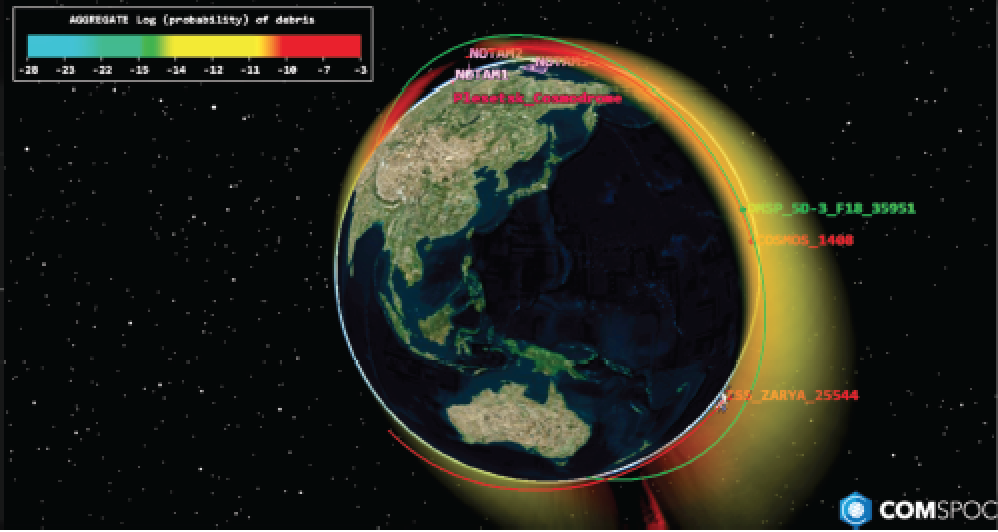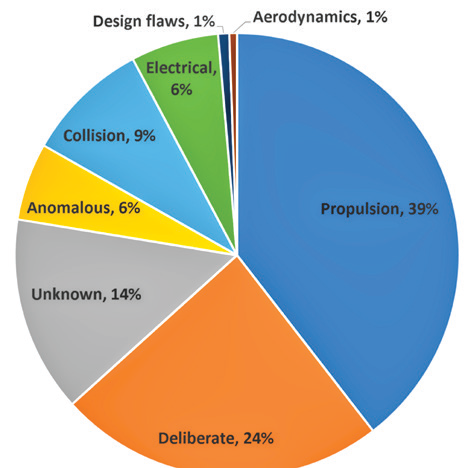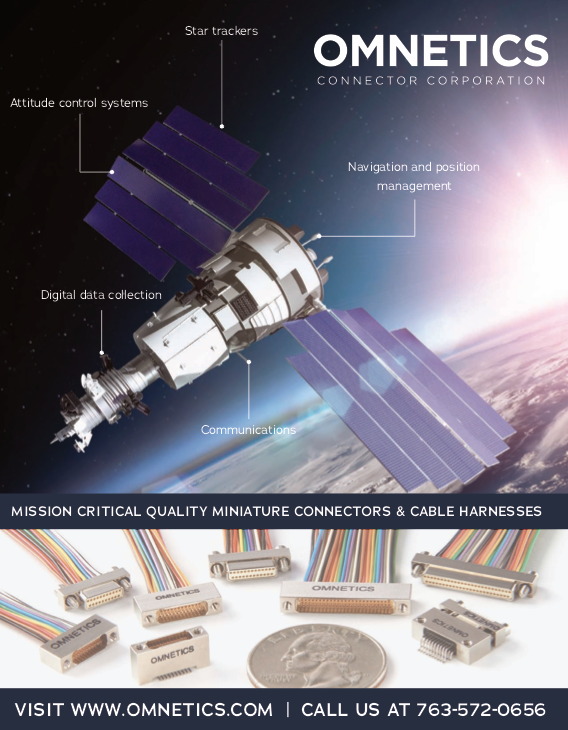Identifying responsible behaviors in space.
The year is 1863 at Gettysburg, Pennsylvania, a fierce American battle that turned the tide of the American Civil War. In the aftermath, the battlefield was impossible to clean up and largely unusable. Farming families found it too challenging to operate there and many were forced to move away, some permanently and others until the passage of time, natural decay, and difficult work rendered the area usable once again. The Gettysburg aftermath strikingly parallels the degrading effect of last November’s Russian ASAT test (https://comspoc.com/News/Default.aspx) on our fragile space environment.

Regrettably, countries have increasingly weaponized space. Though less severe than the Chinese ASAT test of 2007, the recent Russian ASAT test introduced over a thousand debris fragments. Such tests can challenge space operations for years, until — as with the Gettysburg battle — the passage of time, natural decay, and hard work (i.e., active debris removal) gradually cleanses the space environment. Unfortunately, natural decay for space can range from years to centuries to eons. In the meantime, space weapons testing and posturing continue, putting at risk both humans and vital satellite functions critical for humanity including Earth observation, weather monitoring, disaster recovery, security, and communications.
It is time to prioritize both space safety and sustainability, making this adage especially relevant today: we need to say what we mean and mean what we say.
The Space Safety Coalition (SSC), founded in 2019, provides invaluable best practices for space operations (https://spacesafety.org/best-practices). These best practices are unique in embracing and adopting tenets of the United Nations (UN), Inter-Agency Debris Coordination Committee (IADC), International Organization for Standardization (ISO), and Consultative Committee for Space Data Systems (CCSDS). These have been augmented by an additional 42 industry best practices endorsed by over 50 space companies and non- governmental organizations from a dozen countries. Many spacecraft operators are keenly aware of what is an acceptable practice and what is not, and the SSC provides an important conduit for voicing and building consensus on responsible behaviors.
Interestingly, the November 2021 ASAT test directly violated one of Russia’s own space safety policies, putting at risk hundreds of spacecraft and satellites including the International Space Station. Any spacecraft transiting the colored regions in the above figure will experience a risk of collision with the post-ASAT debris fragments, ranging from lower risk (green) to medium risk (yellow) and highest relative risk (red). The ISS ranks among the top 20 of spacecraft, with other critical space assets needlessly placed in harm’s way (Russian ASAT test (https://comspoc.com/News/Default.aspx). Spacecraft operators are now at heightened alert and will have to exercise increased vigilance, care, and collision avoidance maneuvering for several years.
Intentional fragmentation is not the only space safety policy being violated. Other central tenets of our global space sustainability plan are repeatedly ignored, including limiting our post-mission orbit lifetime to less than 25 years, effectively passivating spacecraft, limiting the release of debris (ideally a net-zero operation), and ensuring that spacecraft are effectively disposed at least 90% of the time.
We need to leave space in a habitable, operable state, but that is not the trajectory that the global space community is currently on.
I am often asked, “Why focus on the development of space industry best practices when minimum consensus UN, IADC, ISO, and CCSDS treaties, guidelines, and standards are not fully complied with?” The obvious answer is, “Why not?”
 Orbital regimes put at risk by recent ASAT test (colored regions, with red depicting highest risk and yellow depicting medium risk) — CREDIT: COMSPOC Corporation
Orbital regimes put at risk by recent ASAT test (colored regions, with red depicting highest risk and yellow depicting medium risk) — CREDIT: COMSPOC Corporation
All too often, people get stuck in binary thinking mode, asking questions like, “What is the single most important way we can ensure the sustainability of space operations?”, or “Is top-down national regulation more important than bottom-up aspirational space industry best practices?” As shown in the figure below, there are many causes of space debris, and we need the entire space community to address each of the root causes of space debris to achieve space sustainability. Having such a binary mindset on what steps to take is both biased and risky because no single discipline, entity, research area, or regulatory framework can, by itself, address space safety and sustainability. Let’s stop kidding ourselves that it can. Addressing the challenge requires a multifaceted space community effort that includes NGOs, military, civil, commercial, academia, and amateur elements.
Space sustainability demands a holistic, leave-no-stone-unturned approach, one that pursues all aspects of space safety and sustainability. That is not to say that all avenues should be resourced or pursued with equal priority, but they should be pursued, nonetheless. Our global space community is a vast enterprise. The elements that comprise it can all do their part without interfering with another element’s ability to do so, so that we can collectively up our game. Are we forced to prioritize between academic research, commercial research and innovation, improved Space Situational Awareness, Active Debris Removal, government regulations, commercial best practices, UN and IADC guidelines, or NGOs? No. All these elements are key components of the virtuous cycle that constitutes our space governance and sustainability framework.
The SSC continues to gain momentum with more countries and organizations endorsing its best practices document, which continues to evolve to include critical refinements and enhancements to maintain these best practices. Banning intentional fragmentation, enhanced cyber security, and root cause anomaly investigation and mitigation are paramount, as are rules of the road (RotR).
RotR is a critical ongoing discussion, but so far, there has been no meaningful consensus on its definition, let alone any aspirational or normative content. Some advocate that actual rules - in the form of regulations - be established, while others suggest industry best practices are sufficient. Establishing expectations is a critical first step in this process. Some point to air traffic rules or maritime “give way” procedures as base frameworks for space RotR. It is critical, however, to remember that space travel is fundamentally different from air and sea travel. Any accident or intentional fragmentation in space leaves long-lived debris that doesn’t immediately fall out of the sky or sink to the seabed. Instead, it continues to complicate future use of that orbital regime. We also do not yet have in space the air travel concepts of flight levels that serve to automatically deconflict flight paths, or requirements that specific flight plans be filed. Unlike maritime law, spacecraft operators often don’t have the innate observability and access to accurate and timely SSA information to know whether another operator has maneuvered their spacecraft, and if so, whether they have performed an avoidance maneuver. In any case, RotR is just one aspect of overall best practices which the SSC is interested in.

Sources of Space Debris — CREDIT: Derived from
European Space Agency characterization,
© ESA / UNOOSA
In addition to the SSC’s continuing development of RotR and sustainability best practices, SSC participants actively serve as lead editors, thought leaders, and strategic contributors to the development of critical international space standards that the SSC can embrace and incorporate. These include interoperability through the establishment of space data standards for orbit, attitude, conjunction, reentry, tracking, fragmentation, and launch data messages in CCSDS, and sustainability best practices for orbital debris mitigation, passivation, orbit lifetime estimation, on-orbit and launch conjunction assessment, Space Traffic Coordination (STC), and the operation of Large Constellations (LCs) through ISO.
Sustainability initiatives are gaining momentum internationally and domestically. In the United Nations Committee for the Peaceful Use of Outer Space (UN COPUOS), the Long- Term Sustainability of Outer Space Activities Working Group is assembling to advance its 21 LTS guidelines and focus on ways to implement them. UN COPUOS is also developing a work plan for a new working group focused on legal models for space resource utilization.
Domestically, the U.S. National Space Council and the Department of Commerce are re-energizing discussions about what constitutes safe and appropriate behavior in space. The White House has unveiled the Space Priorities Framework. Meeting attendees vigorously discussed that framework, RotR, and norms of behavior in space. These positive developments demonstrate a global sense of urgency of executing robust space safety measures and systems.

Daniel Oltrogge
International cooperation is critical to protecting the expanding space environment. With this growth comes a global responsibility to identify and abide by appropriate behaviors in space. We can’t afford to wait.
Daniel Oltrogge is the Founder and Administrator of the Space Safety Coalition and Director of Integrated Operations and Research for COMSPOC Corporation.



